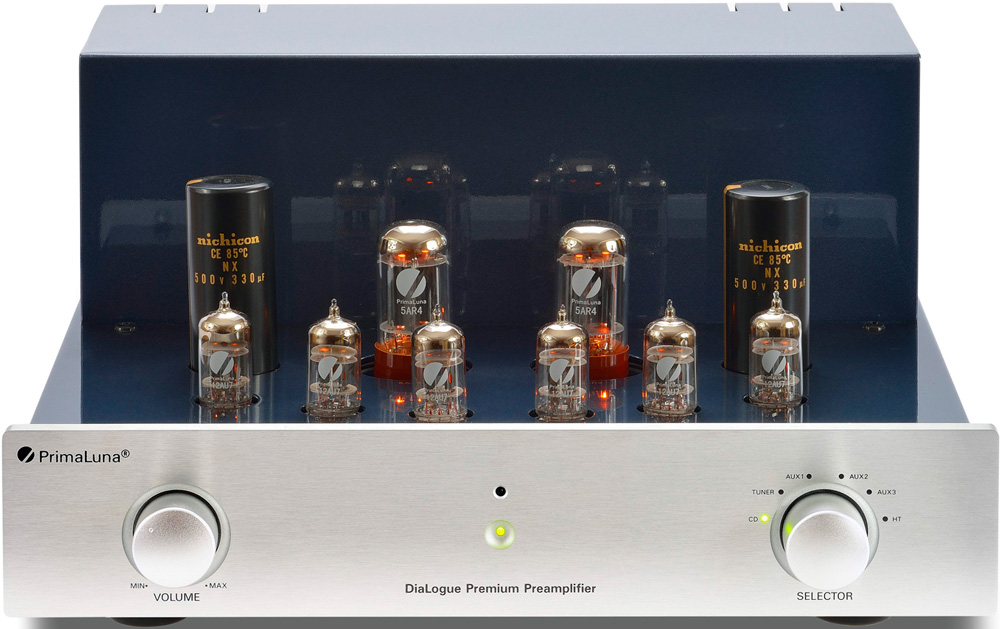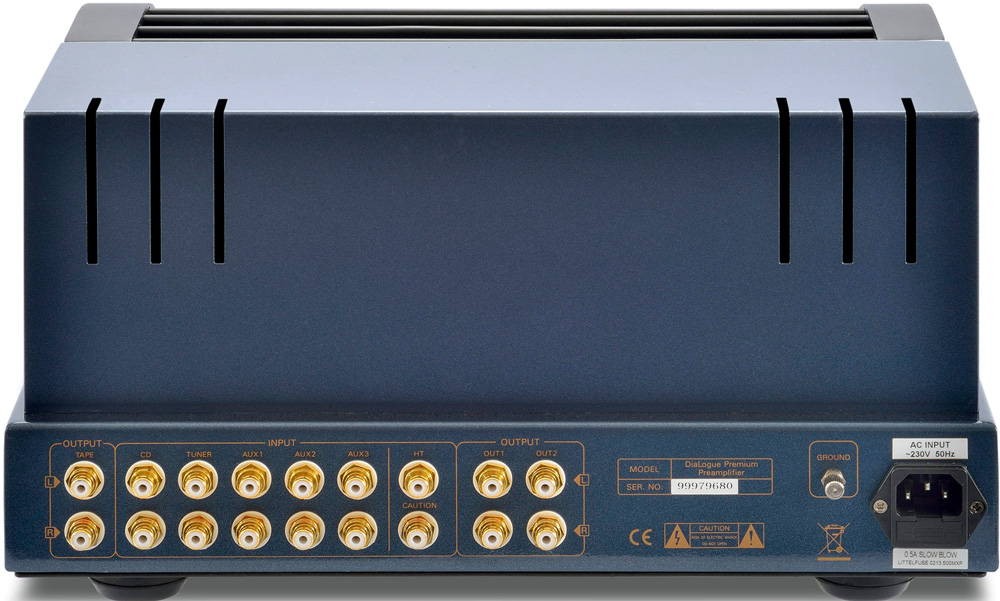Santa came early this year
After wrapping up my review of the PrimaLuna DiaLogue Premium HP power amplifier and my subsequent purchase of the loaner, I emailed importer Kevin Deal to discuss the merits of using the KT150 output tube in PrimaLuna amplifiers. While I like the KT120 mentioned in the review, I feel there is a slight loss of transparency in my system when compared with the stock EL34 tubes. One thing led to another, Kevin asked if I wanted to listen and assess the DiaLogue Premium preamplifier, since I now owned the companion power amplifier. Does the sun rise from the East every morning? “Of course,” I answered affirmatively. Soon, I was opening two packages, one containing an octet of the KT150 output tubes, and the other the DP preamplifier.
The DiaLogue Premium preamplifier is PrimaLuna’s flagship in its preamplifier line-up and retails for $3,199. Since the preamplifiers and amplifiers in the Premium series are designed to work in tandem with each other, there should be excellent synergy between the preamplifier and my HP power amplifier.
The DiaLogue Premium preamplifier has a complement of six 12AU7 and two 5AR4 rectifier tubes. PrimaLuna’s use of tube rectification is very much old school, since there’s an increasing tendency for modern tube equipment designers to use solid-state diodes for rectification.
It’s a dual-mono design, and equipped with plenty of RCA connections: five inputs, two pre-out pairs, one tape out and a designated home theater pass through. Notice I didn’t mention balanced connections anywhere because there are none. The DiaLogue Premium comes standard as a line-level active preamplifier, but an optional phono stage is available for $249 (moving magnet cartridges only) and can be easily soldered to one set of the RCA inputs inside the existing chassis by your dealer.
Like all Premium models in the DiaLogue series, top quality parts from high-end suppliers, like an ALPs Blue Velvet motorized volume control, or SCR tinfoil capacitors, are used almost everywhere in the various circuits. I could go on and list more quality parts, safety protection circuits, or, the attention-to-detail that has become the hallmark of PrimaLuna, all of which results in maximizing the probability of long-life and reliability. But why rehash what the reader can find on the company website, or what others have written on these important reasons to ponder when one is considering purchasing an audio component?
I will mention that this preamplifier has only 10dB of gain, which is great if you have high efficiency loudspeakers, or have noise problems from other preamplifiers. And with an output impedance of 256 ohm (Kevin says it’s among the lowest of any tube preamp) the DiaLogue preamp can be used with any solid-state amplifier available. This very low impedance is achieved without cathode followers or feedback; hence the three gain tubes per channel.
After careful inspection, it appears to me that the same chassis is used for both the Dialogue Premium preamplifier and power amplifier, and I suspect this is true for all of the company’s components in each series. Both units have the same on and off rocker switch near the front of the left side panel. The DiaLogue Premium preamp also has the same soft start circuitry as my HP power amplifier. This economy of scale approach helps keep the overall costs down, and the savings are usually passed on to the consumer.
I thought this DiaLogue Premium preamplifier would weigh about half as much as its HP power amplifier sibling. Boy was I wrong! This monster tips the scale at over 50 pounds, making it only slightly lighter than its behemoth brother from the same mother.
A nice and heavy aluminum remote control is included, and has all the necessary functions-except power on/off- to operate the unit while you remain comfortably in your seat, drinking a banana daiquiri or whatever you like to imbibe. One nifty feature on the remote is the mute button, which mutes not only the preamplifier but also the companion HP power amplifier simultaneously. How cool is that? Another is the triode/ultralinear button, which enables switching between the two modes. I no longer have to use my HP power amplifier remote for that purpose. That’s simplifying things, and gets my two thumbs up award!
Associated equipment for this review included my PrimaLuna Dialogue Premium HP power amplifier, AAD 2001 stand-mount speakers, music dedicated Asus laptop loaded with JRiver 20 music player, Oppo 981 as CD transport, and iFi Micro iDSD DAC to interpret the data. A selection of Redbook CDs, 44.1 kHz WAV files and hi-res files of both PCM and DSD varieties were used for the audition.
On to the music: locked in two-step harmony
Initially, the preamplifier sounded somewhat closed-in and exhibited a little veiling to the music. After about six or so days of burn-in the unit started to open up nicely. With all those vacuum tubes in my system I was expecting to hear some tube related noise, but I heard nothing from my listening position-approximately seven and a half feet away from the speakers. I had to put my ear right in front of the speakers to hear an almost inaudible faint noise from the right speaker. For tube electronics, that’s like hitting a home run!
Among the new generational musicians, two that I admire are Daniel Martin Moore and Fionn Regan. Both Moore and Regan are planted in the folk genre, although their stylistic roots are different: Moore from Appalachia and Regan from Ireland. Regan has often been compared lyrically to the young Bob Dylan, and I tend to agree. With the right audio equipment and listening environment, recordings of these two musicians can evoke an emotional connection similar to what I experience at their live concerts. On Fionn Regan’s wonderfully melodic album, The End of History, especially the song, “The Cowshed” I was deeply immersed in his interpretative phrasings and musicality. In my opinion, The End of History is a beautiful conception from beginning to end, and the PrimaLuna duo does a masterful job of conveying the musical message.
I usually listen to Daniel M. Moore’s In the Cool of the Day when I want to unwind and the track, “Set Things Aright” (not a typo) as a reference for the level of sibilance a component reproduces. Depending on the component, with this song sometimes the sibilance I hear is too much (bright sounding), sometimes I hear what I consider is natural (perfect), or sometimes I don’t hear any or very little (lack of high frequency or dullness). I also reference the song to determine a component’s ability to distinguish separation and layering of instruments. On “Set Things Aright” the PrimaLuna duo reproduced Moore’s sibilant delivery quite naturally, while each instrument (guitar, banjo, upright bass, mandolin, violin, drums and Haley Bonar’s backup vocals) sounded separate and tonally distinct from the others. Some equipment I have auditioned has tonally and spatially blended the instruments together.
Ida Maria’s Fortress ‘round My Heart is a flawed recording and she is a flawed singer, but she makes up for those negatives with supreme feeling and effort, like on “In the End,” appropriately the last song of the album. It’s a simple tune with Ida’s gutsy singing, accompanied by an acoustic guitar, piano and a backup chorus. I listened spellbound from beginning to “the End” because the PrimaLuna equipment, along with the rest of my system, allowed Ida to convey her expressive punctuations in the song hypnotically.
I think Chesky Records did a nice digital transfer from the original analog master tape of Rene Leibowitz conducting Beethoven’s Symphony No. 2 and No.5. The PrimaLuna duo delivered nice harmonic realism of live acoustic instruments. The presentation of micro and macro dynamic ranges was near excellent. This is one of the reasons why I have always owned active preamplifiers-except for one instance which I considered was the best sounding of the passive breed at that time. Except for one or two exceptions, in my experience I have found passive preamplifiers or attenuators terrific at presenting transparency, resolution, and image specificity, but lacking a bit in macro-dynamics and bass impact. I have not heard any of the latest generation of passive models (say in the past six years or so), so I can’t comment whether they have improved in those areas. I can say the DiaLogue duo was neither lacking in dynamics-either micro or macro-nor bass impact.
Oh Joni Mitchell, you make me Blue but I keep using your album because it is so darn delightful. On “California,” Joni wraps me around her finger and sings to me intimate, homesick tales of that great state, and on “Blue” the PrimaLuna duo allows me to hear all of her micro-volume, inflection and cadence changes. Wow, the hair on my back stood up-that’s if I had any.
- (Page 1 of 2)
- Next page →



Thank you for great review, Mr. Mah. How would you compare this PrimaLuna preamp to the preamps from Rogue Audio you’d reviewed before?
Hi Jungsoo,
Since I own the Rogue Super Magnum 99 preamp I can compare the two directly. In my system the two preamps sound very similar, with the differences being the Rogue sounding a little darker and slightly more robust or fuller, while the PL sounding a little cleaner and a little more transparent. I think the differences may be attributable to the type of tubes used: Rogue = 6SN7 and PL = 12AU7 and maybe the circuit designs of each. In my opinion, they are both great preamps and it depends
on what type of sound one prefers.
Cheers,
Paul
Thank you once again for the excellent review Mr. Mah. I was wondering how the KT150 compared with the KT120 tubes since it appears that you had the former in hand when you wrote this review.